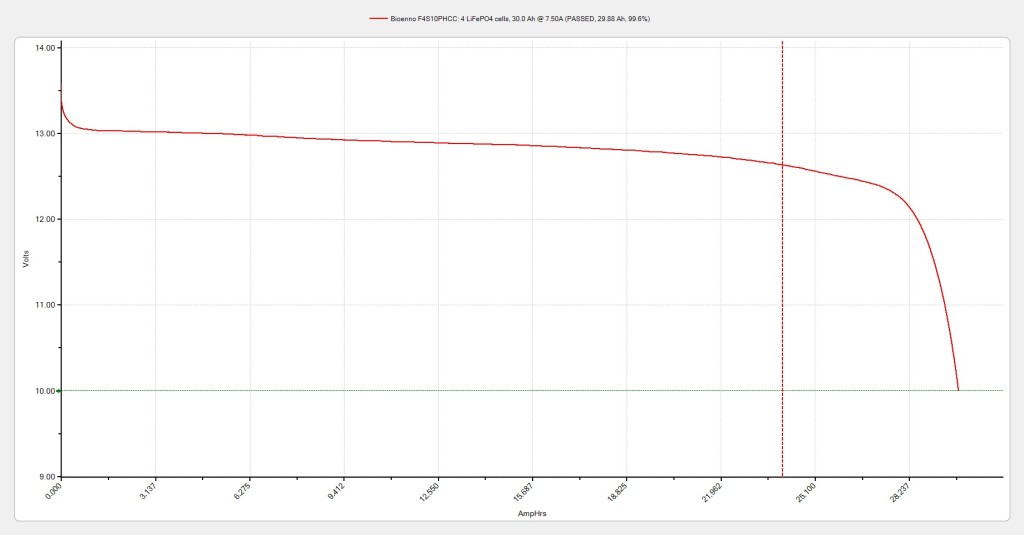I finally had a chance to run a test on my Bioenno Power FL4S10PHCC 30 AH, 12 V, LiFePO4 battery this weekend. I would normally do my testing at a C/2 rate, or 15 Amps in this case, but that exceeds the 10 amp capacity of my test equipment. So I settled on a C/4 rate of 7.5 Amps. The battery was given a full charge cycle after being received new from the factory, then subject to a 7.5 Amp constant-current discharge until it reached a terminal voltage of 10.0 volts. The results indicated a measured capacity of 29.88 AH, very close to the nameplate capacity. Here is the test graph:
The battery remained above 12.0 volts for 228 minutes (95% of nameplate capacity), then remained above 10.0 volts for the next 10 minutes.










Hi,
I’ve been studying your blogosphere. Thanks for all your work here. I just ordered a new KX3 with all the options. You seem to have a well rounded experience with the LiFePo4s. I’ve been looking into Tenergy, K2-Energy, Bioenna and others. I think I’m leaning toward getting a Powerfilm 20W folding solar panel and a Dimensionengineering.com Anyvolt3 DC/DC converter along with a 12.8 v 10 ah LiFePo4 battery with BMS. You convinced me that bare LiFePo4 packs are too “adventurous”. I see on EBay that Bioenno includes PCM (protection circuit module) and an AC charger. I need some clarification. BMS does not equal PCM, right? I’m having trouble seeing BMS spelled out in LiFePo4 battery descriptions. If an inexpensive Clean Republic LiFePo4 says “SLA drop in replacement”, does that mean BMS? I’m led to believe that I should also shy away from just PCM. What do you think?
I would like to simply charge and use a LiFePo4 pack from an AC charger at home, DC in the car and conditioned solar power in the field. Am I being unrealistic? Do I need to figure in a special DC to DC charge controller specific to the LiFePo4 battery I choose in addition to my DC/DC converter conditioned solar power? Also do I need to steer away from batteries that don’t specifically state “BMS”?
Very Respectfully
Rich, AA6VX
Hey Rich,
PowerFilm panels are great, expensive, but great. I’ve output tested several of them over a period of years and they generally output a bit more than they claim. If you a size/weight conscious, they can’t be beat.
It is hard to say what one vendor means by PCM or BCM or BMS. The best thing is to check the details. For example, for K2-Energy and BioEnno, their battery control modules protect against over charging, over discharging, short circuits, and they balancing the cells internally. Some of the cheaper batteries simply protect from overcharging. The latter will generally require you to keep the battery on the charger for 8-10 hours, even though it may indicate that the charge process is complete (usually just reaching a voltage threshold). That’s because the balance process shifts a few milliamps of charge into one specific battery, swapping between batteries, until they have equal voltages. That may take some time. I can’t speak for what is in the Tenergy batteries.
BioEnno comes with a battery charger specifically sized for their batteries, so there is no need to buy one or mess with settings. LiFePO4 batteries are really pretty simple. The start in a current limit mode until the battery voltage increases to the point where the current starts dropping off. They then do a final protection by making sure the voltage never gets higher than 14.6 volts (for a 4-series configuration). The transition from current to voltage limit happens in a matter of seconds or minutes depending on battery capacity.
In your setup, there is little need for the Anyvolt3 DC/DC converter, which will be a source of HF noise. That’s one of the key advantages of LiFePO4 technology — they maintain a high and essentially flat discharge voltage for about 85% of their capacity. You can expect a voltage above 13 volts for quite some time out of a fully charged battery. So there is no reason for this.
You can generally get by without a charge controller if you use PowerFilm folding panels. This is because their maximum output voltage is not as high — they’ve been optimized for 13.8 volt systems. HOWEVER, that assumes your battery has a BMS. But what will happen is that your will see the voltage on the battery remain at 14.6 volts until the battery is completely full and balanced. At that point the voltage will shoot up to about 19-20 volts when the battery disconnects itself. That high a voltage could fry your radio if it were attached to the battery at the same time.
So the best way is to purchase a charge controller optimized for charging LiFePO4 cells from a solar panel. Your panel is small enough that you could use the BuddiPole charge controller == I’d recommend that for a 20 watt panel. http://www.buddipole.com/sobaco.html (its small, light weight).
The next step up would be a Genasun MPPT Controller. Check internet prices (which may be half of what list is) but here is a link to the vendor: http://genasun.com/products-store/mppt-solar-charge-controllers/mppt-for-lithium-batteries/ You want one for a 4-series LiFePO4 battery.
In theory, those batteries sold as “Drop-in SLA Replacements” SHOULD include a full BMS system. But you have to check the details. I would only buy a device from a known brand for that reason.
You might need to purchase a special charger, like one used by the RC folks, to be able to charge a LiFePO4 battery from your car DC jack. The reason is your car’s voltage system is too low to fully charge a 4-series LiFePO4 battery. Second, you wouldn’t have a current limit (outside of something like a 30 amp fuse in a cigarette outlet). And those chargers are not obvious in terms of how to use (often requiring non-obvious setting to get a useful voltage for charging a LiFePO4).
Cheap batteries without controllers, such as those sold into the RC model marketplace have not performed well for me despite using a special balancing controller. I’ve had too many cells fail. Often times shipping charges added to the base battery price really don’t make these a bargain, plus when something goes wrong, shipping them back to Hong Kong isn’t very attractive.
73, Bob, WB4SON
Bob,
Thank you for the helpful response and clarifying the BMS/PCM configurations. I will nix the Anyvolt3 unless I need to charge SLAs. It sounds like the Buddypole is good my my needs.
On another note, I’ve got Eneloop XX 2500s and Powerex 2700s and a Maha 801D charger ordered for the KX3 when it comes in. I’ll probably like the 2500s better with the lower self discharge but I wanted to try them both.
73
Rich, AA6VX
Hi Bob,
Great post and thanks for sharing. I’m looking at both K2 and Bioenno, among others, for a 12V off-grid solar solution. The comparable Bioenno model is significantly cheaper than the K2, by 20%, but I felt a lot more confident talking with the K2 rep (he was much, much more knowledgeable).
Seems like you’ve had good experiences with the Bioenno products? Have you noticed (or heard from others) any issues with quality, warranty service, etc?
Thanks!
Bryan
Hi Bryan,
I’ve had a long and productive experience with K2 Energy. I like the batteries I’ve bought in the past and they have proven themselves over 3+ years. Bioenno Power is a “new” supplier for me. I’ve only had one of their 30 AH batteries for about 4 months now. So far its been great. The capacity tests have indicated no issues. I haven’t run a long-duration self-discharge test yet because that takes months (like six), and I’m using the battery all the time during the summer. Once this winter comes, I’ll give the battery a final charge, then let it sit for a half year and test the capacity.
That said, I know of a couple more 30 AH batteries that were purchased by friends and have been heavily used. So far no issues.
K2 Energy has not kept up with either product offerings or competitive pricing in my opinion. Their stuff is great, but is overpriced compared to the market (nothing could be more overpriced than BuddyPole — great stuff but 2X what it is worth). I am VERY impressed with the number of new offerings form Bioenno, and at least from a marketing point of view, I think they are trying to grow their business and understand what each of the niche markets need to do so (providing Anderson PowerPole connectors, for example, and having models with separate as well as combined charge/discharge connectors). They are very competitively priced, offer a decent warranty, and are a US company, all pluses as far as I am concerned.
Not trying to oversell them at all, but I think they are worthy of consideration. I will be doing follow-up testing in the future. And I will probably try some of their newer 3 and 6 AH packs (good for KX3 users).
73, Bob
I just bought the KX3 and I have similar questions,
Thanks for the info.
Does it matter how many AH you get 5, 10, 30.
The rep said you should supply 13.2 volts.
I have a solar panel but it is the Goal zero 7 watt one. will that need a charge controller also?
I plan on using it to charge AA bateries, but I want something bigger as well to get mor power out.
Thanks in advance for your help
Steve Milligan W1IEU
Hi Steve,
The KX3 pulls between 2 and 3 amps on transmit, and about 0.2 amps on receive, so you just need to be sure that your battery can supply the required peak current. The AH rating is determined by you based on how much time you need (“average” draw for casual operation is about 0.3 amps per hour, so a 3 AH battery would run the rig for approximately 10 hours), how much money you have, and how large/heavy a battery you want to lug around. LiFePO4 batteries are pretty close to ideal in this application, and even a small 3 AH one (about $58 with AC charger) will run the KX3 at full power for a days outing.
Many of the batteries being used have built in protection electronics. Were you to attempt to charge them directly from a solar panel, they will dutifully disconnect the battery from the solar panel when full (but not necessarily balanced), allowing the solar panel to go open circuit, which produces from 18 to 22 volts (depending on the panel). That might be a high enough voltage to damage the protection electronics inside the battery, or anything attached to the battery. In my opinion, always use a charge controller when charging a battery from a solar panel. The BuddiPole solar controller (http://www.buddipole.com/sobaco.html) is easy to use, very small/light, and is fairly inexpensive.
Finally there are plenty of AA chargers that will run on 12 VDC, that you could use off your car supply, or battery/solar panel. There are a few folding chargers that will charge AA cells directly, like those by PowerFilm and other companies. PowerFilm often sells their higher powered panels via Amazon at substantial discount. I’ve been told that when large orders are placed, they have to build extra units to ensure they have more than enough to fill the complete order. These extra panels are then sold at a discount. I paid less than half price for my 60 watt panel just by waiting for a special price.
Robert
Thank you very much for answering my questions.
Steve
Hello!
I’m going to purchase this battery for mobile HF operation with an IC-1700 (100 watts).
I have a Kia Soul with a SMALL battery so I am going to power my mobile operation from the Bioenno.
I Have a clip mount antenna that is going to be grounded to the rear hatch. The question is do I have to ground my car like a traditional setup where one uses the car battery for power? I plan on driving to a location, setting up the antenna with the ignition OFF.
Any thoughts
73 Jeff
Hi Jeff,
You are pretty much doing what I do. I don’t rely on my truck battery (even though it is quite large) because I want to be sure it will start at the end of the day! Also a car/truck battery is more like 12.0 volts when the engine isn’t running and that is on the low side.
I purchased a Bioenno 30 AH LiFePO4 years ago and it is still working great. Just make sure to buy the companion charger.
If you wouldn’t mind another suggestion regarding your antenna. You might consider a mag mount with a HamStick antenna. Put it on the middle of the roof rather than offset like you are planning with your lip mount. That combo will be very effective on 20 meters.
No I don’t do anything special to tie the rig to the chassis. It might help a bit with the RF ground. But since you are on an independent battery, there is no need to worry about the car electrical system ground.
Good luck and enjoy!
73, Bob, WB4SON
Hi,
Just wanted to say thanks for a great write up. I’ve got a couple of the Bioennos. 30 & 12 AH. Very pleased with both. Solar is 120w and 28W bio enno as well. The 120s are heavy, but the efficiency seems good. The big rig box gets an epic PowerGate as a controller/charge manager and the QRP package uses a Budipole.
Your comments are spot on. Thanks.
73 W4DBL
Great picture.
Hi Doug! Glad they are working for you. My oldest is from 2014 now and is still working great. Ran my Field Day Satellite station for 12 hours (35 AH). Lots of my club members have purchased them as well. Not cheap, but they meet their specs and don’t die after a few hundred cycles like SLA batteries do.
73, Bob, WB4SON
Bob,
I’m about to get another 12 ah to put in the car. I’ve got a MB with a three battery electrical system and I don’t want to accidentally fry something. I’m going to put an Epic per gate in and run the charging and load through that. Hopefully, that will keep from costing me an electrical system. Not the cheapest, but does isolate the load from the car some.
Enjoy the weekend.
Hi Bob,
Thanks for the very helpful information. I’m looking for a power source for mobile operations with an IC-7100. I was initially thinking about a dual battery installation with (with each battery chargeable via the alternator) and a battery isolator, but there isn’t room for a second battery in the engine compartment, and installing the isolator and running cables through the firewall, etc. with fuses in the power cables would add complexity and expense.
I was interested to read in your post from June 8, 2019 that you use a Bioenno 30 AH battery to directly power your mobile rig without connection to your vehicle’s power system. This seems like it would be a much simpler solution than what I was thinking about, and I was wondering where and how you have mounted your battery in your vehicle. Also, I was wondering if there is a way of charging the Bioenno battery off the vehicle alternator (without running cabling directly to the alternator). My car (a Kia Sorento) actually has a 110V/150W built in inverter supplying AC, and I was wondering if this could be used in conjunction with a charger from Bioenno.
Thanks again for the helpful information above, and thanks in advance for any comments or suggestions.
73,
John
KCØQVF
Hi John
The BioEnno battery that I use is a 10″Wx10″Lx6″H plastic box with a carry strap, so I simply place the battery on the seat of the car and connect it directly to the rig with a short power-pole cable. When using it for satellite work, there is no connection to the truck at all. When operating using a HamStick on HF, there is a capacitive connection to the truck body as it becomes the ground-plane.
I would NOT charge the battery off the car alternator as the voltages are not very compatible. A LiFePO4 battery is usually charged using a constant voltage charger of 14.6 volts, and is also current limited to a value that is compatible with the capacity of the battery. For the 30 AH battery, I use the 14.6 volt setting and a current limit of 3 Amps. So a completely dead battery would take 10 hours to charge plus a bit more due to inefficiencies (much lower than a lead-acid battery, by the way — so don’t expect that LiFePO4 battery to get “warm” due to charging).
I usually charge mine from a solar panel using a MMPT solar charge controller specifically for a LiFePO4 4-cell battery.
73, Bob